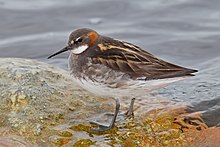Phalaropus lobatus
| Red-necked phalarope | |
|---|---|
 |
|
| Breeding plumage | |
 |
|
| Winter plumage | |
| Scientific classification | |
| Kingdom: | Animalia |
| Phylum: | Chordata |
| Class: | Aves |
| Order: | Charadriiformes |
| Family: | Scolopacidae |
| Genus: | Phalaropus |
| Species: | P. lobatus |
| Binomial name | |
|
Phalaropus lobatus (Linnaeus, 1758) |
|
 |
|
| Range of P. lobatus Breeding range Wintering range | |
The red-necked phalarope (Phalaropus lobatus) is a small wader. The English and genus names for phalaropes come through French phalarope and scientific Latin phalaropus from Ancient Greek phalaris, "coot", and pous, "foot". Coots and phalaropes both have lobed toes. The specific lobatus is New Latin for lobed, for the same reason. This bird was described in 1750 as the "Coot-footed Tringa".
This phalarope breeds in the Arctic regions of North America and Eurasia. It is migratory, and, unusually for a wader, winters at sea on tropical oceans.
The red-necked phalarope was one of the many bird species originally described by Linnaeus in the landmark 1758 10th edition of his Systema Naturae, where it was given the binomial name of Tringa lobata. It has also been known as the northern phalarope.
The red-necked phalarope is about 18 cm (7.1 in) in length, with lobed toes and a straight, fine bill. The breeding female is predominantly dark grey above, with a chestnut neck and upper breast, black face and white throat. They have a white wing stripe which helps distinguish this bird from the similar Wilson's phalarope. The breeding male is a duller version of the female. They have lobed toes to assist with their swimming. Young birds are grey and brown above, with buff underparts and a black patch through the eye. In winter, the plumage is essentially grey above and white below, but the black eyepatch is always present. They have a sharp call described as a whit or twit.
The typical avian sex roles are reversed in the three phalarope species. Females are larger and more brightly coloured than males. The females pursue and fight over males, and will defend their mate from other females until the clutch is complete and the male begins incubation. The males perform all incubation and chick-rearing activities, while the females may attempt to find another mate. If a male loses his eggs to predation, he may re-pair with his original mate or a new female to try again. Once it becomes too late in the breeding season to start new nests, females begin their southward migration, leaving the males to incubate the eggs and look after the young.
...
Wikipedia

